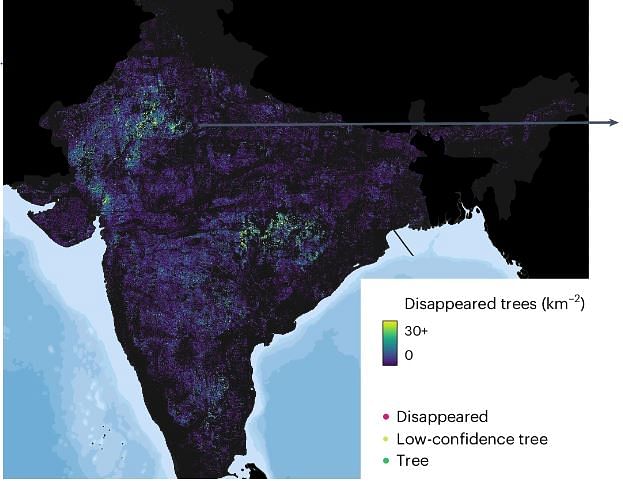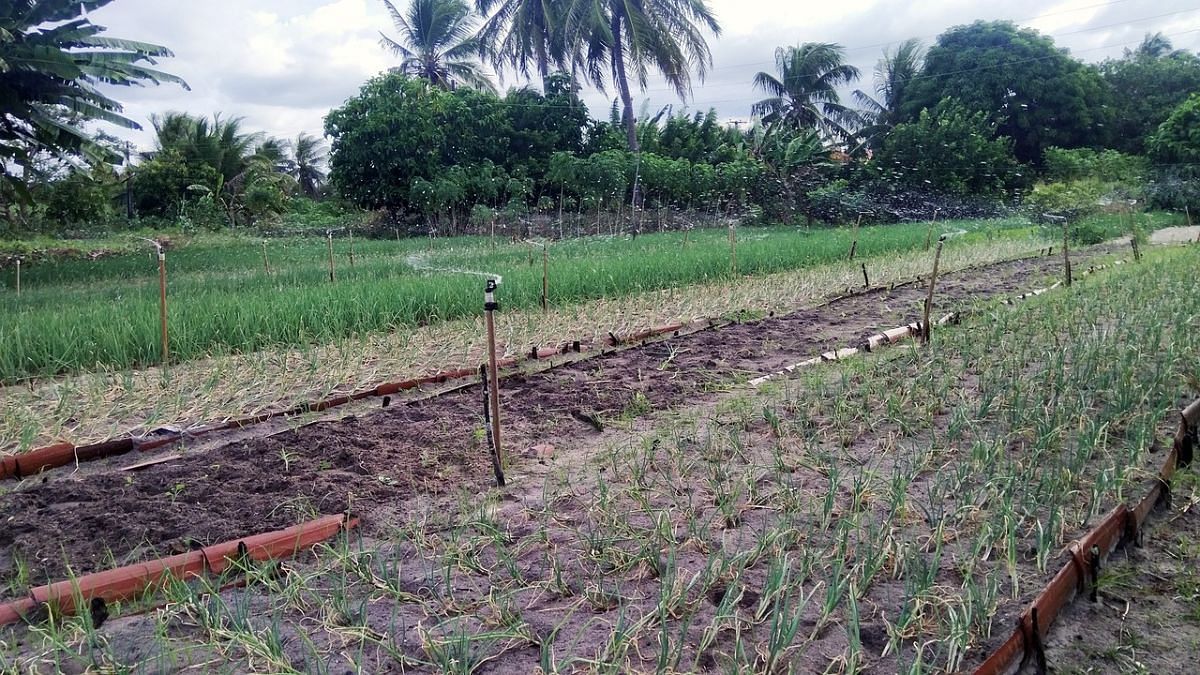Bengaluru: More than five million large-sized farmland trees, used in agroforestry, which are usually grown individually in farms and offer multiple socio-ecological benefits, were felled between 2018 and 2022 in India to make land available for farming, a new study has said. The team of Denmark-based researchers, who evaluated Indian agroforestry practices, also found that around 11 percent of India’s large trees, mapped previously in 2010-2011, had disappeared by 2018.
The study, published this week in the journal Nature Sustainability, noted that areas where most trees had disappeared were in the states of Telangana and Maharashtra, where some hotspots lost nearly half their trees. Smaller hotspot areas were also observed in eastern Madhya Pradesh around Indore, with the highest losses generally occurring in central India.
Researchers used satellite views over the years for their study. High-definition satellite images were obtained from 2010 to 2022, and the crown areas or the canopy size of trees were measured to inform size.
Further analysis revealed that these trees were mature and quite old, and the high loss rate of mature trees in less than a decade is “unexpected”.
Authors of the study corroborated their findings with detailed interviews with local villagers in Telangana, Andhra Pradesh, Kerala, Maharashtra, Uttar Pradesh, Haryana, and Kashmir. Unanimous responses indicated that giant trees were felled to expand paddy fields to boost crop yields.
According to researchers, the study “reveals a concerning trajectory, documenting a considerable depletion of large farmland trees over the past decade in parts of India”.
They found the results “particularly unsettling”, in the context of the growing awareness about agroforestry playing a crucial role in climate adaptation and mitigation strategies, including sustaining livelihoods and protection of crops. They also mentioned that their estimation of loss of trees is “conservative” due to the satellite observation methods used.
The study, however, clarifies that the findings do not contradict official reports stating that India’s tree cover has increased in recent years because large plantations of trees were not considered for the study, especially due to their lack of contribution to biodiversity.
The team also made an interactive tool with satellite imagery available online, showing the outcomes of its research.
Also Read: Making of a geomagnetic storm — ISRO puts out data on solar ejections captured from Earth, Moon & space
Observed patterns in farming practices
While wildfires, fungal infections, droughts and insects tend to cause naturally-occurring tree mortality in forests, human misuse of land resources and anthropogenic climate change have steeply accelerated tree die-offs. However, there has been minimal research yet about die-offs outside forested areas, especially in areas like drylands or farms.
Agroforestry trees are a crucial part of tree planting and restoration today, which is a land-use practice that incorporates widely beneficial trees in agricultural areas. India has historically adopted a number of traditional agroforestry practices on farms.
These trees include Azadirachta indica (neem), Cocos nucifera (coconut), Madhuca longifolia (mahua), Artocarpus heterophyllus (jackfruit), Prosopis cineraria (ghaf/khejri/jammi), Acacia nilotica (babul), Dalbergia sissoo (shisham), Syzygium cumini (jamun), Sesbania grandiflora (agati/katurai), Albizia procera (karoi), and more. They provide a number of ecological benefits and services like soil fertilisation, protection of crops, shade, provision of fruits, fibre, medicine, etc.
Today, 56 percent of India is covered by farmland, the largest agricultural cover in the world, while 20 percent of the country is covered by forest vegetation.
Trees, like the neem and jackfruit, have been traditionally grown on farms, rising up to great heights and living for hundreds of years. Many, in recent years, have succumbed to fungal and other infections, the researchers noted, but such numbers are hard to track as there exists no inventory of large trees in India in non-forested areas.
For the study, the authors excluded groups and perennial plantations of trees like palm and rubber, which have large closed canopies that are typically classified as tree cover. They used high resolution satellite images for the period of 2010-2011, and then for the years 2018-2022. Comparison of these yielded the observation about the trees that went missing between 2011 and 2018.
Data showed that 22 million trees from the previous dataset remained, but nearly 2.5 million individual trees disappeared between 2011 and 2018. In total, a loss of about 11 percent of trees was observed. Additionally, large trees in the dataset for 2018-2022 dropped in huge numbers.
The authors stated that between 2018 and 2022, 5.6 million trees disappeared. Mature trees across most of the country faced a loss of 5-10 percent, except areas in central India. Satellite imagery accompanying the paper shows large losses in parts of Telangana and Maharashtra.

The researchers observed that infections have a smaller role to play in the disappearance of trees, and detailed interviews with villagers from multiple states show that changing agricultural practices led to tree felling to expand paddy fields. This was especially common in areas where new water supply systems were built.
Climate change caused by humans and physical felling of trees for intensification of agriculture are credited for this massive agroforestry tree loss in India.
The scientists explained that such changes lead to simplification of not just natural, but also cultural landscapes. This, in turn, leads to loss of biodiversity, release of carbon, and disappearance of indigenous knowledge about the ecological working of agroforestry systems that were in use for decades or centuries.
The paper also notes, “despite receiving limited attention, diverse and complex multifunctional landscapes are still maintained by indigenous peoples and smallholders”, referring to farmers with less than 2 hectares of land, who make up 86 percent of India’s farmers.
(Edited by Mannat Chugh)
Also Read: Astronomy conferences generated 42,000 tonnes CO2 in 2019, virtual or local meets could help cut this

